Malaria in Africa: Environmental Determinants, Public Health Report
VerifiedAdded on 2023/01/19
|10
|2679
|59
Report
AI Summary
This report provides a systematic review of the environmental determinants of malaria in sub-Saharan Africa. The report explores the impact of various environmental factors on malaria transmission, disease outcome, and seasonality. The study highlights the significant burden of malaria in the region, particularly among pregnant women and children under five. It examines the methodology used, which includes a systematic search of databases and the application of inclusion criteria to select relevant articles. The report identifies key environmental risk factors such as socio-economic status, urban agricultural practices, and poor housing conditions, emphasizing the need for improved environmental hygiene and better housing. The study also discusses the implications for public health, emphasizing the need for government action and effective measures to control the disease and reduce its impact on public health. The report concludes by highlighting areas where more research is needed and the importance of understanding the environmental factors to develop more efficient malaria control tools.
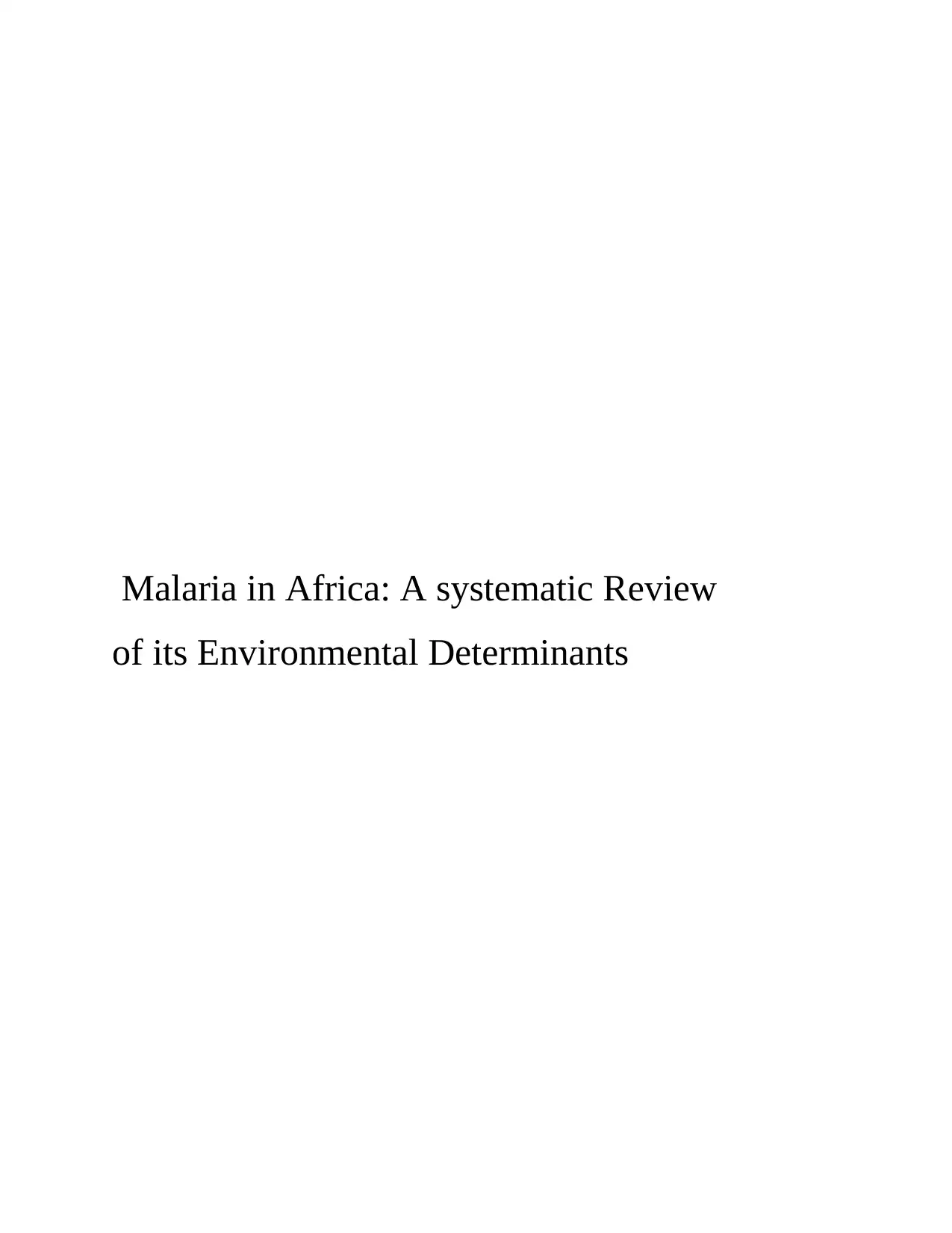
Malaria in Africa: A systematic Review
of its Environmental Determinants
of its Environmental Determinants
Paraphrase This Document
Need a fresh take? Get an instant paraphrase of this document with our AI Paraphraser
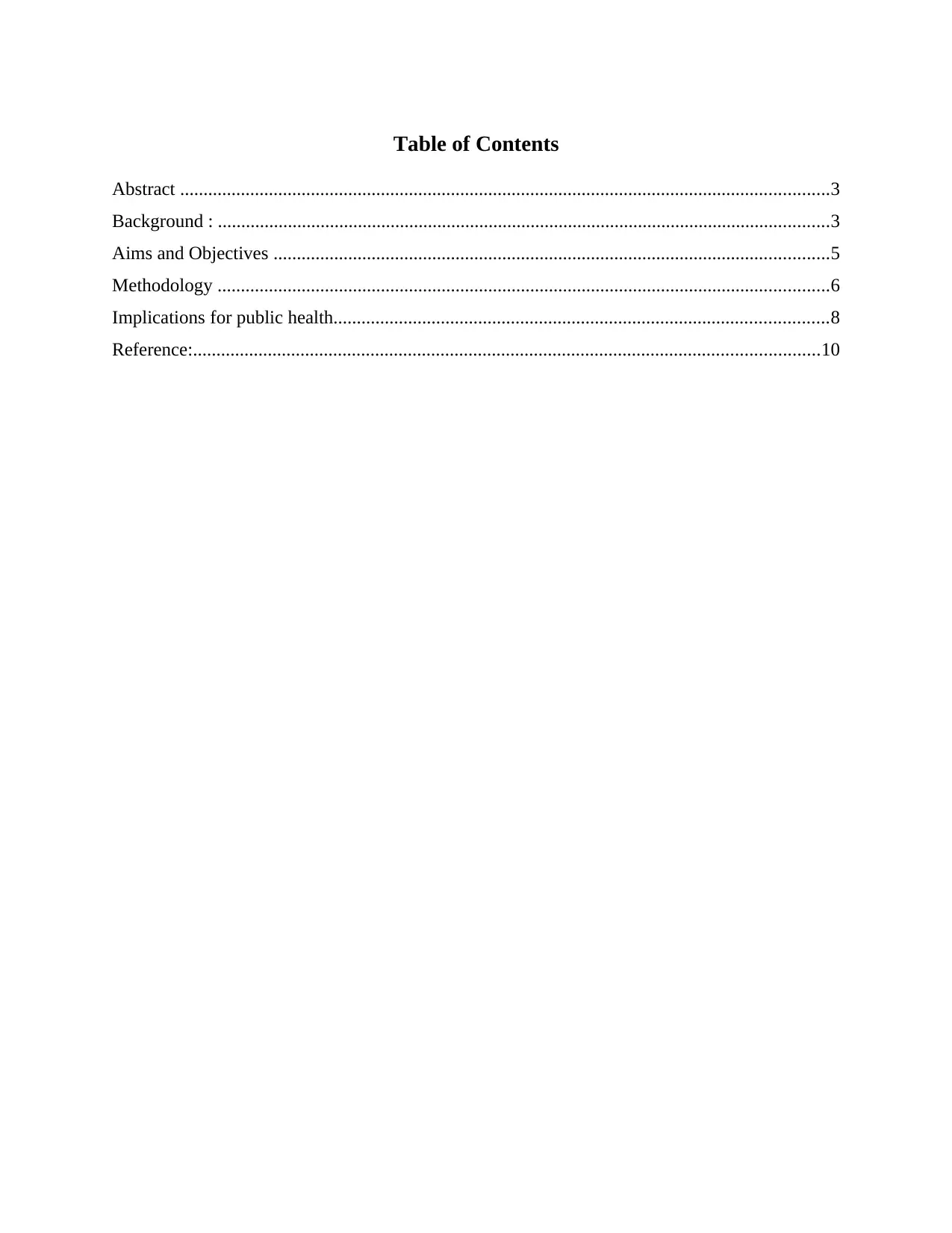
Table of Contents
Abstract ...........................................................................................................................................3
Background : ...................................................................................................................................3
Aims and Objectives .......................................................................................................................5
Methodology ...................................................................................................................................6
Implications for public health..........................................................................................................8
Reference:......................................................................................................................................10
Abstract ...........................................................................................................................................3
Background : ...................................................................................................................................3
Aims and Objectives .......................................................................................................................5
Methodology ...................................................................................................................................6
Implications for public health..........................................................................................................8
Reference:......................................................................................................................................10
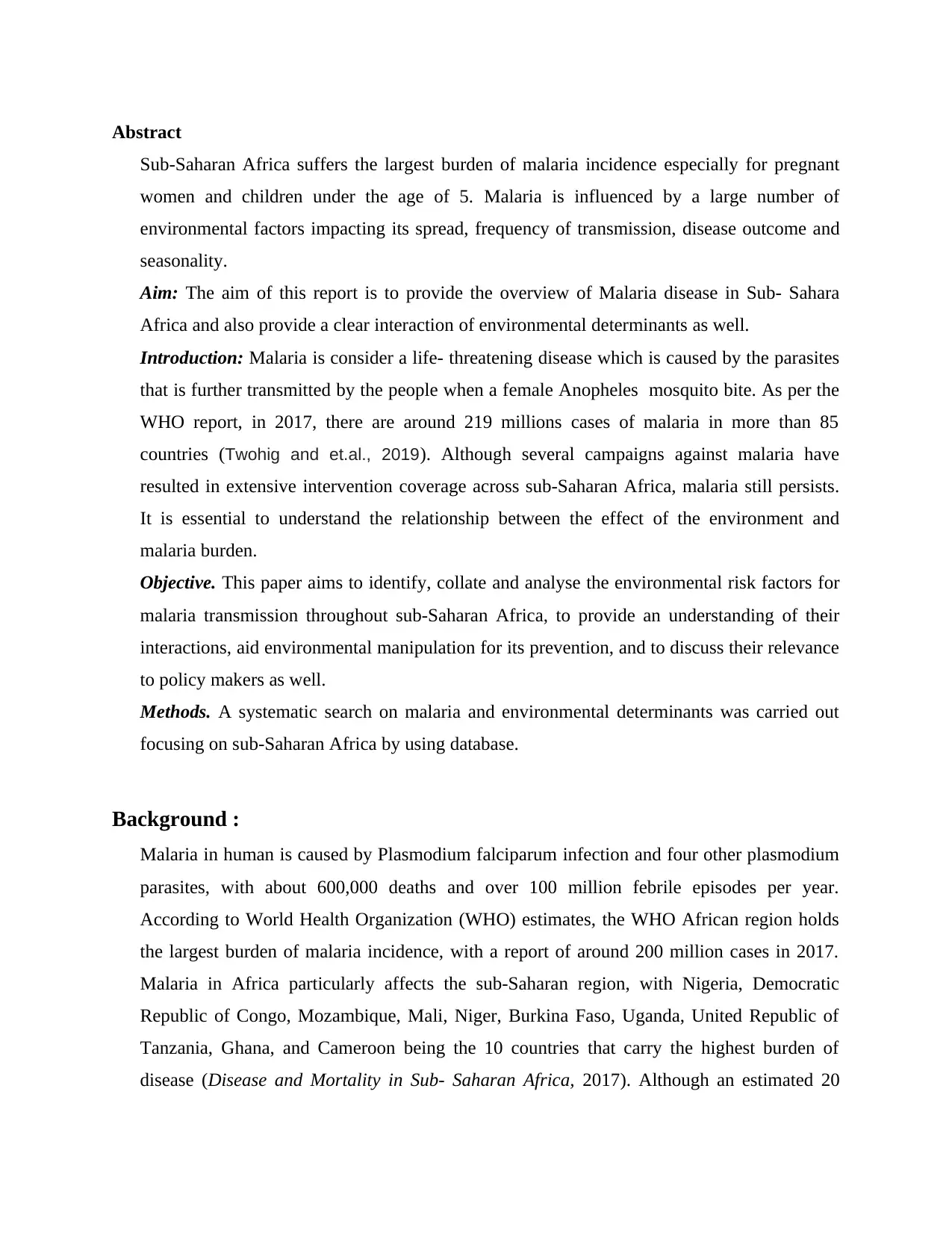
Abstract
Sub-Saharan Africa suffers the largest burden of malaria incidence especially for pregnant
women and children under the age of 5. Malaria is influenced by a large number of
environmental factors impacting its spread, frequency of transmission, disease outcome and
seasonality.
Aim: The aim of this report is to provide the overview of Malaria disease in Sub- Sahara
Africa and also provide a clear interaction of environmental determinants as well.
Introduction: Malaria is consider a life- threatening disease which is caused by the parasites
that is further transmitted by the people when a female Anopheles mosquito bite. As per the
WHO report, in 2017, there are around 219 millions cases of malaria in more than 85
countries (Twohig and et.al., 2019). Although several campaigns against malaria have
resulted in extensive intervention coverage across sub-Saharan Africa, malaria still persists.
It is essential to understand the relationship between the effect of the environment and
malaria burden.
Objective. This paper aims to identify, collate and analyse the environmental risk factors for
malaria transmission throughout sub-Saharan Africa, to provide an understanding of their
interactions, aid environmental manipulation for its prevention, and to discuss their relevance
to policy makers as well.
Methods. A systematic search on malaria and environmental determinants was carried out
focusing on sub-Saharan Africa by using database.
Background :
Malaria in human is caused by Plasmodium falciparum infection and four other plasmodium
parasites, with about 600,000 deaths and over 100 million febrile episodes per year.
According to World Health Organization (WHO) estimates, the WHO African region holds
the largest burden of malaria incidence, with a report of around 200 million cases in 2017.
Malaria in Africa particularly affects the sub-Saharan region, with Nigeria, Democratic
Republic of Congo, Mozambique, Mali, Niger, Burkina Faso, Uganda, United Republic of
Tanzania, Ghana, and Cameroon being the 10 countries that carry the highest burden of
disease (Disease and Mortality in Sub- Saharan Africa, 2017). Although an estimated 20
Sub-Saharan Africa suffers the largest burden of malaria incidence especially for pregnant
women and children under the age of 5. Malaria is influenced by a large number of
environmental factors impacting its spread, frequency of transmission, disease outcome and
seasonality.
Aim: The aim of this report is to provide the overview of Malaria disease in Sub- Sahara
Africa and also provide a clear interaction of environmental determinants as well.
Introduction: Malaria is consider a life- threatening disease which is caused by the parasites
that is further transmitted by the people when a female Anopheles mosquito bite. As per the
WHO report, in 2017, there are around 219 millions cases of malaria in more than 85
countries (Twohig and et.al., 2019). Although several campaigns against malaria have
resulted in extensive intervention coverage across sub-Saharan Africa, malaria still persists.
It is essential to understand the relationship between the effect of the environment and
malaria burden.
Objective. This paper aims to identify, collate and analyse the environmental risk factors for
malaria transmission throughout sub-Saharan Africa, to provide an understanding of their
interactions, aid environmental manipulation for its prevention, and to discuss their relevance
to policy makers as well.
Methods. A systematic search on malaria and environmental determinants was carried out
focusing on sub-Saharan Africa by using database.
Background :
Malaria in human is caused by Plasmodium falciparum infection and four other plasmodium
parasites, with about 600,000 deaths and over 100 million febrile episodes per year.
According to World Health Organization (WHO) estimates, the WHO African region holds
the largest burden of malaria incidence, with a report of around 200 million cases in 2017.
Malaria in Africa particularly affects the sub-Saharan region, with Nigeria, Democratic
Republic of Congo, Mozambique, Mali, Niger, Burkina Faso, Uganda, United Republic of
Tanzania, Ghana, and Cameroon being the 10 countries that carry the highest burden of
disease (Disease and Mortality in Sub- Saharan Africa, 2017). Although an estimated 20
⊘ This is a preview!⊘
Do you want full access?
Subscribe today to unlock all pages.

Trusted by 1+ million students worldwide
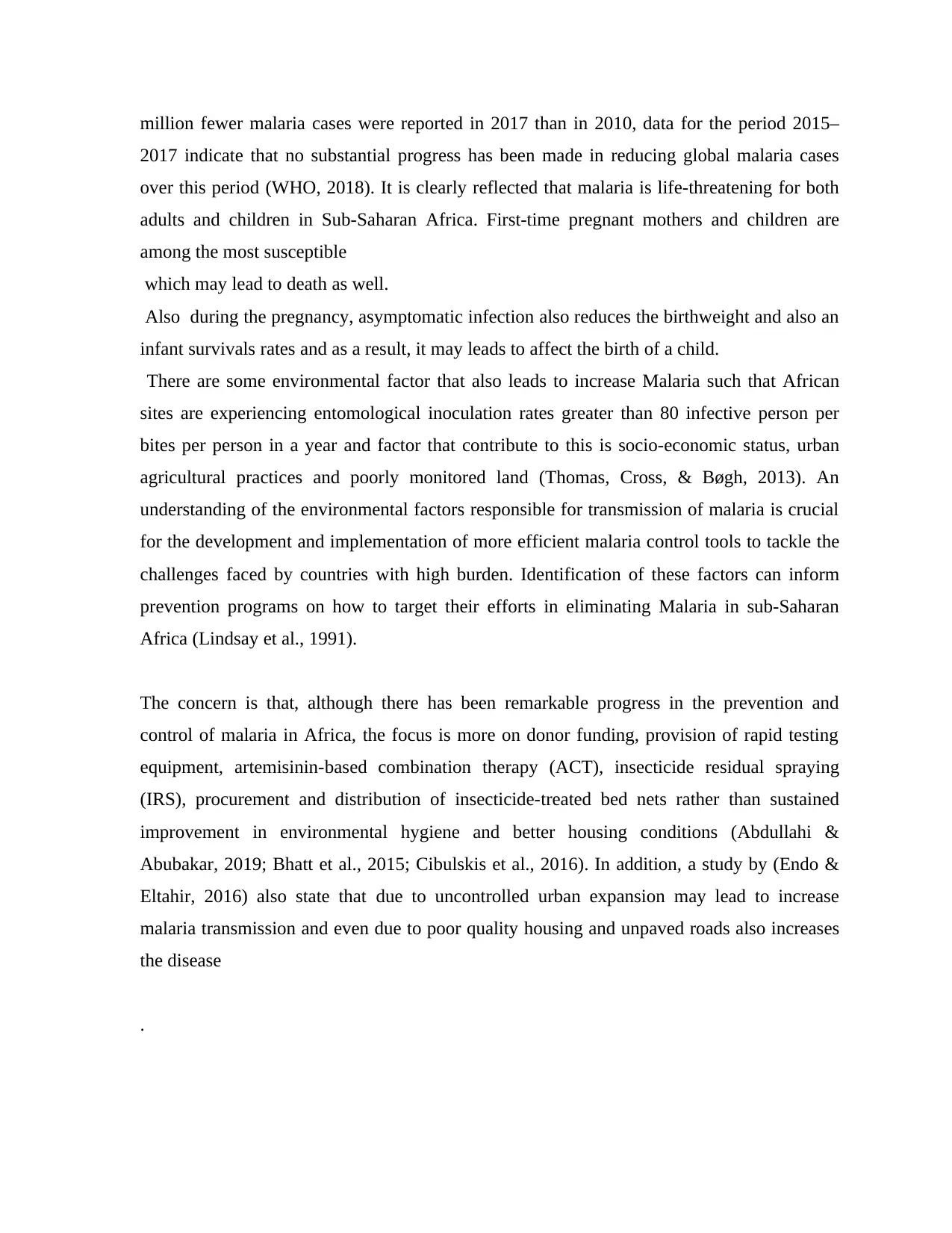
million fewer malaria cases were reported in 2017 than in 2010, data for the period 2015–
2017 indicate that no substantial progress has been made in reducing global malaria cases
over this period (WHO, 2018). It is clearly reflected that malaria is life-threatening for both
adults and children in Sub-Saharan Africa. First-time pregnant mothers and children are
among the most susceptible
which may lead to death as well.
Also during the pregnancy, asymptomatic infection also reduces the birthweight and also an
infant survivals rates and as a result, it may leads to affect the birth of a child.
There are some environmental factor that also leads to increase Malaria such that African
sites are experiencing entomological inoculation rates greater than 80 infective person per
bites per person in a year and factor that contribute to this is socio-economic status, urban
agricultural practices and poorly monitored land (Thomas, Cross, & Bøgh, 2013). An
understanding of the environmental factors responsible for transmission of malaria is crucial
for the development and implementation of more efficient malaria control tools to tackle the
challenges faced by countries with high burden. Identification of these factors can inform
prevention programs on how to target their efforts in eliminating Malaria in sub-Saharan
Africa (Lindsay et al., 1991).
The concern is that, although there has been remarkable progress in the prevention and
control of malaria in Africa, the focus is more on donor funding, provision of rapid testing
equipment, artemisinin-based combination therapy (ACT), insecticide residual spraying
(IRS), procurement and distribution of insecticide-treated bed nets rather than sustained
improvement in environmental hygiene and better housing conditions (Abdullahi &
Abubakar, 2019; Bhatt et al., 2015; Cibulskis et al., 2016). In addition, a study by (Endo &
Eltahir, 2016) also state that due to uncontrolled urban expansion may lead to increase
malaria transmission and even due to poor quality housing and unpaved roads also increases
the disease
.
2017 indicate that no substantial progress has been made in reducing global malaria cases
over this period (WHO, 2018). It is clearly reflected that malaria is life-threatening for both
adults and children in Sub-Saharan Africa. First-time pregnant mothers and children are
among the most susceptible
which may lead to death as well.
Also during the pregnancy, asymptomatic infection also reduces the birthweight and also an
infant survivals rates and as a result, it may leads to affect the birth of a child.
There are some environmental factor that also leads to increase Malaria such that African
sites are experiencing entomological inoculation rates greater than 80 infective person per
bites per person in a year and factor that contribute to this is socio-economic status, urban
agricultural practices and poorly monitored land (Thomas, Cross, & Bøgh, 2013). An
understanding of the environmental factors responsible for transmission of malaria is crucial
for the development and implementation of more efficient malaria control tools to tackle the
challenges faced by countries with high burden. Identification of these factors can inform
prevention programs on how to target their efforts in eliminating Malaria in sub-Saharan
Africa (Lindsay et al., 1991).
The concern is that, although there has been remarkable progress in the prevention and
control of malaria in Africa, the focus is more on donor funding, provision of rapid testing
equipment, artemisinin-based combination therapy (ACT), insecticide residual spraying
(IRS), procurement and distribution of insecticide-treated bed nets rather than sustained
improvement in environmental hygiene and better housing conditions (Abdullahi &
Abubakar, 2019; Bhatt et al., 2015; Cibulskis et al., 2016). In addition, a study by (Endo &
Eltahir, 2016) also state that due to uncontrolled urban expansion may lead to increase
malaria transmission and even due to poor quality housing and unpaved roads also increases
the disease
.
Paraphrase This Document
Need a fresh take? Get an instant paraphrase of this document with our AI Paraphraser
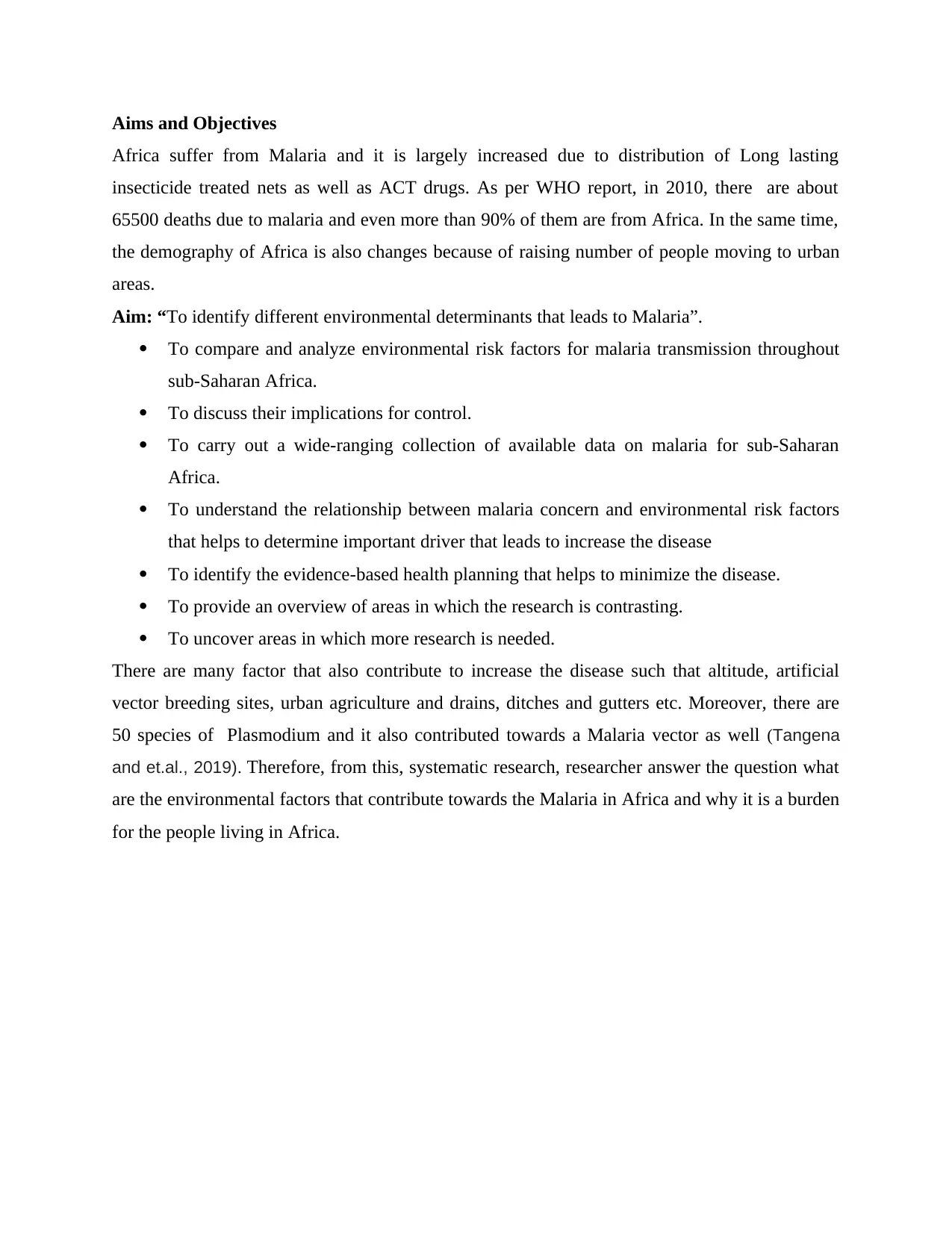
Aims and Objectives
Africa suffer from Malaria and it is largely increased due to distribution of Long lasting
insecticide treated nets as well as ACT drugs. As per WHO report, in 2010, there are about
65500 deaths due to malaria and even more than 90% of them are from Africa. In the same time,
the demography of Africa is also changes because of raising number of people moving to urban
areas.
Aim: “To identify different environmental determinants that leads to Malaria”.
To compare and analyze environmental risk factors for malaria transmission throughout
sub-Saharan Africa.
To discuss their implications for control.
To carry out a wide-ranging collection of available data on malaria for sub-Saharan
Africa.
To understand the relationship between malaria concern and environmental risk factors
that helps to determine important driver that leads to increase the disease
To identify the evidence-based health planning that helps to minimize the disease.
To provide an overview of areas in which the research is contrasting.
To uncover areas in which more research is needed.
There are many factor that also contribute to increase the disease such that altitude, artificial
vector breeding sites, urban agriculture and drains, ditches and gutters etc. Moreover, there are
50 species of Plasmodium and it also contributed towards a Malaria vector as well (Tangena
and et.al., 2019). Therefore, from this, systematic research, researcher answer the question what
are the environmental factors that contribute towards the Malaria in Africa and why it is a burden
for the people living in Africa.
Africa suffer from Malaria and it is largely increased due to distribution of Long lasting
insecticide treated nets as well as ACT drugs. As per WHO report, in 2010, there are about
65500 deaths due to malaria and even more than 90% of them are from Africa. In the same time,
the demography of Africa is also changes because of raising number of people moving to urban
areas.
Aim: “To identify different environmental determinants that leads to Malaria”.
To compare and analyze environmental risk factors for malaria transmission throughout
sub-Saharan Africa.
To discuss their implications for control.
To carry out a wide-ranging collection of available data on malaria for sub-Saharan
Africa.
To understand the relationship between malaria concern and environmental risk factors
that helps to determine important driver that leads to increase the disease
To identify the evidence-based health planning that helps to minimize the disease.
To provide an overview of areas in which the research is contrasting.
To uncover areas in which more research is needed.
There are many factor that also contribute to increase the disease such that altitude, artificial
vector breeding sites, urban agriculture and drains, ditches and gutters etc. Moreover, there are
50 species of Plasmodium and it also contributed towards a Malaria vector as well (Tangena
and et.al., 2019). Therefore, from this, systematic research, researcher answer the question what
are the environmental factors that contribute towards the Malaria in Africa and why it is a burden
for the people living in Africa.
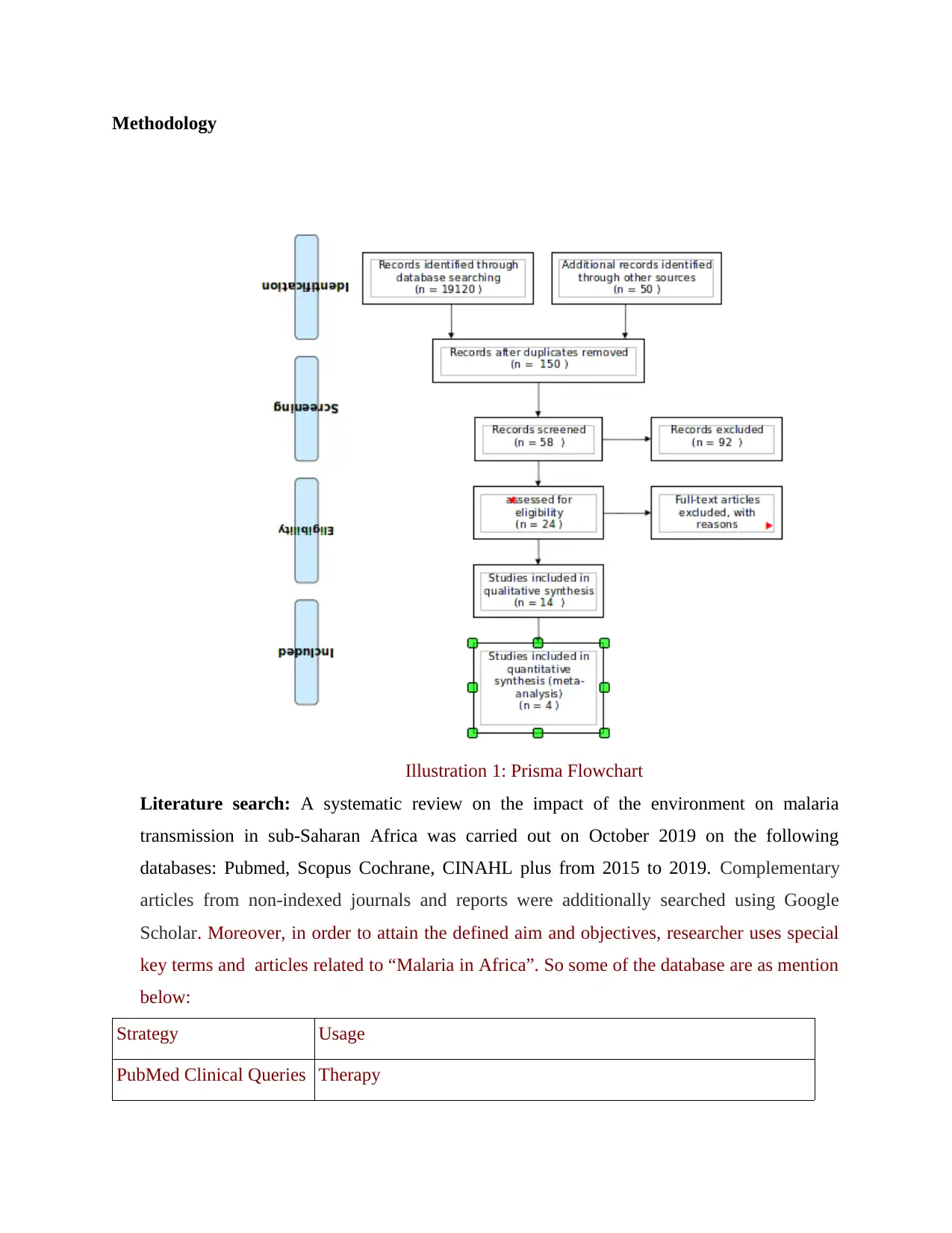
Methodology
Literature search: A systematic review on the impact of the environment on malaria
transmission in sub-Saharan Africa was carried out on October 2019 on the following
databases: Pubmed, Scopus Cochrane, CINAHL plus from 2015 to 2019. Complementary
articles from non-indexed journals and reports were additionally searched using Google
Scholar. Moreover, in order to attain the defined aim and objectives, researcher uses special
key terms and articles related to “Malaria in Africa”. So some of the database are as mention
below:
Strategy Usage
PubMed Clinical Queries Therapy
Illustration 1: Prisma Flowchart
Literature search: A systematic review on the impact of the environment on malaria
transmission in sub-Saharan Africa was carried out on October 2019 on the following
databases: Pubmed, Scopus Cochrane, CINAHL plus from 2015 to 2019. Complementary
articles from non-indexed journals and reports were additionally searched using Google
Scholar. Moreover, in order to attain the defined aim and objectives, researcher uses special
key terms and articles related to “Malaria in Africa”. So some of the database are as mention
below:
Strategy Usage
PubMed Clinical Queries Therapy
Illustration 1: Prisma Flowchart
⊘ This is a preview!⊘
Do you want full access?
Subscribe today to unlock all pages.

Trusted by 1+ million students worldwide
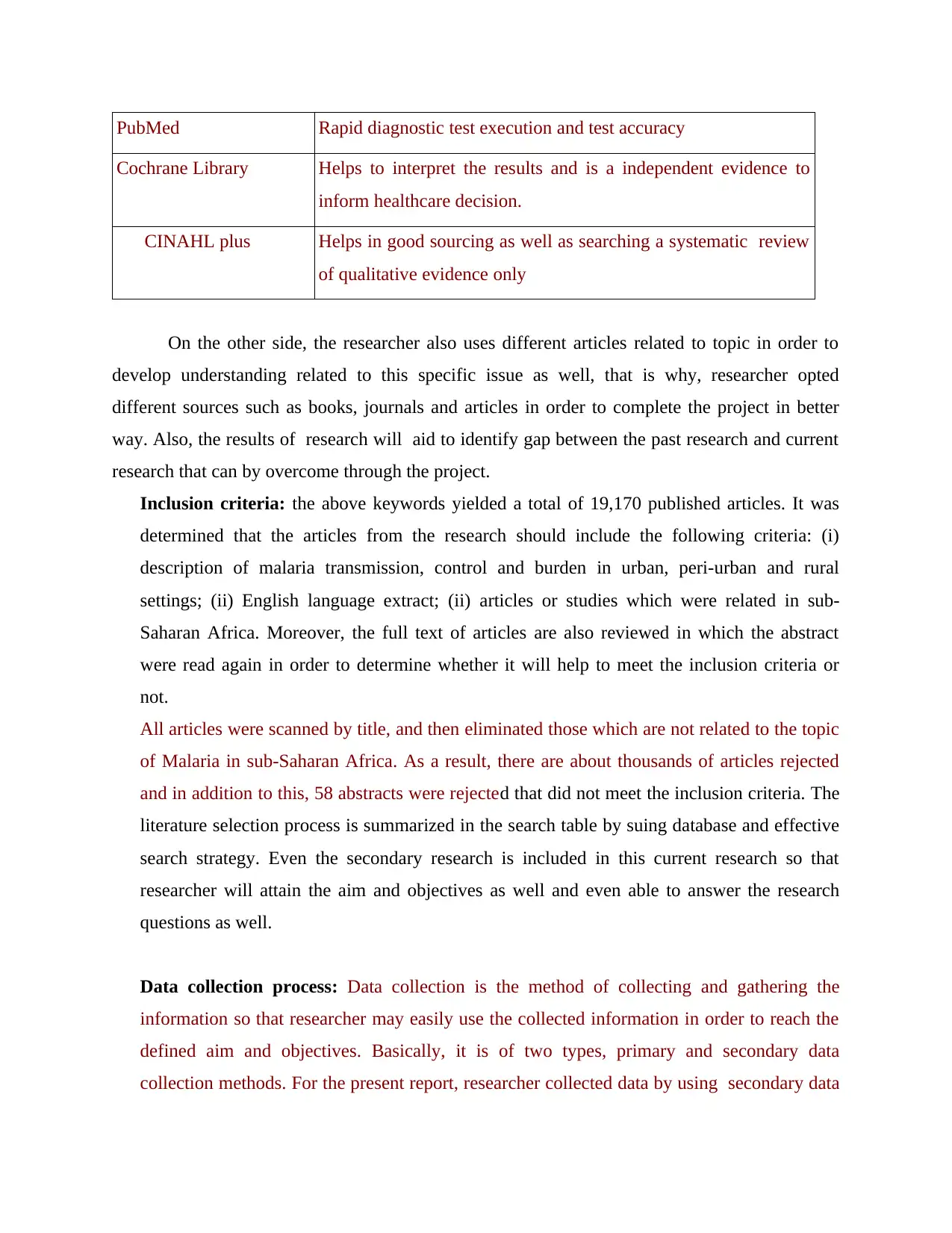
PubMed Rapid diagnostic test execution and test accuracy
Cochrane Library Helps to interpret the results and is a independent evidence to
inform healthcare decision.
CINAHL plus Helps in good sourcing as well as searching a systematic review
of qualitative evidence only
On the other side, the researcher also uses different articles related to topic in order to
develop understanding related to this specific issue as well, that is why, researcher opted
different sources such as books, journals and articles in order to complete the project in better
way. Also, the results of research will aid to identify gap between the past research and current
research that can by overcome through the project.
Inclusion criteria: the above keywords yielded a total of 19,170 published articles. It was
determined that the articles from the research should include the following criteria: (i)
description of malaria transmission, control and burden in urban, peri-urban and rural
settings; (ii) English language extract; (ii) articles or studies which were related in sub-
Saharan Africa. Moreover, the full text of articles are also reviewed in which the abstract
were read again in order to determine whether it will help to meet the inclusion criteria or
not.
All articles were scanned by title, and then eliminated those which are not related to the topic
of Malaria in sub-Saharan Africa. As a result, there are about thousands of articles rejected
and in addition to this, 58 abstracts were rejected that did not meet the inclusion criteria. The
literature selection process is summarized in the search table by suing database and effective
search strategy. Even the secondary research is included in this current research so that
researcher will attain the aim and objectives as well and even able to answer the research
questions as well.
Data collection process: Data collection is the method of collecting and gathering the
information so that researcher may easily use the collected information in order to reach the
defined aim and objectives. Basically, it is of two types, primary and secondary data
collection methods. For the present report, researcher collected data by using secondary data
Cochrane Library Helps to interpret the results and is a independent evidence to
inform healthcare decision.
CINAHL plus Helps in good sourcing as well as searching a systematic review
of qualitative evidence only
On the other side, the researcher also uses different articles related to topic in order to
develop understanding related to this specific issue as well, that is why, researcher opted
different sources such as books, journals and articles in order to complete the project in better
way. Also, the results of research will aid to identify gap between the past research and current
research that can by overcome through the project.
Inclusion criteria: the above keywords yielded a total of 19,170 published articles. It was
determined that the articles from the research should include the following criteria: (i)
description of malaria transmission, control and burden in urban, peri-urban and rural
settings; (ii) English language extract; (ii) articles or studies which were related in sub-
Saharan Africa. Moreover, the full text of articles are also reviewed in which the abstract
were read again in order to determine whether it will help to meet the inclusion criteria or
not.
All articles were scanned by title, and then eliminated those which are not related to the topic
of Malaria in sub-Saharan Africa. As a result, there are about thousands of articles rejected
and in addition to this, 58 abstracts were rejected that did not meet the inclusion criteria. The
literature selection process is summarized in the search table by suing database and effective
search strategy. Even the secondary research is included in this current research so that
researcher will attain the aim and objectives as well and even able to answer the research
questions as well.
Data collection process: Data collection is the method of collecting and gathering the
information so that researcher may easily use the collected information in order to reach the
defined aim and objectives. Basically, it is of two types, primary and secondary data
collection methods. For the present report, researcher collected data by using secondary data
Paraphrase This Document
Need a fresh take? Get an instant paraphrase of this document with our AI Paraphraser
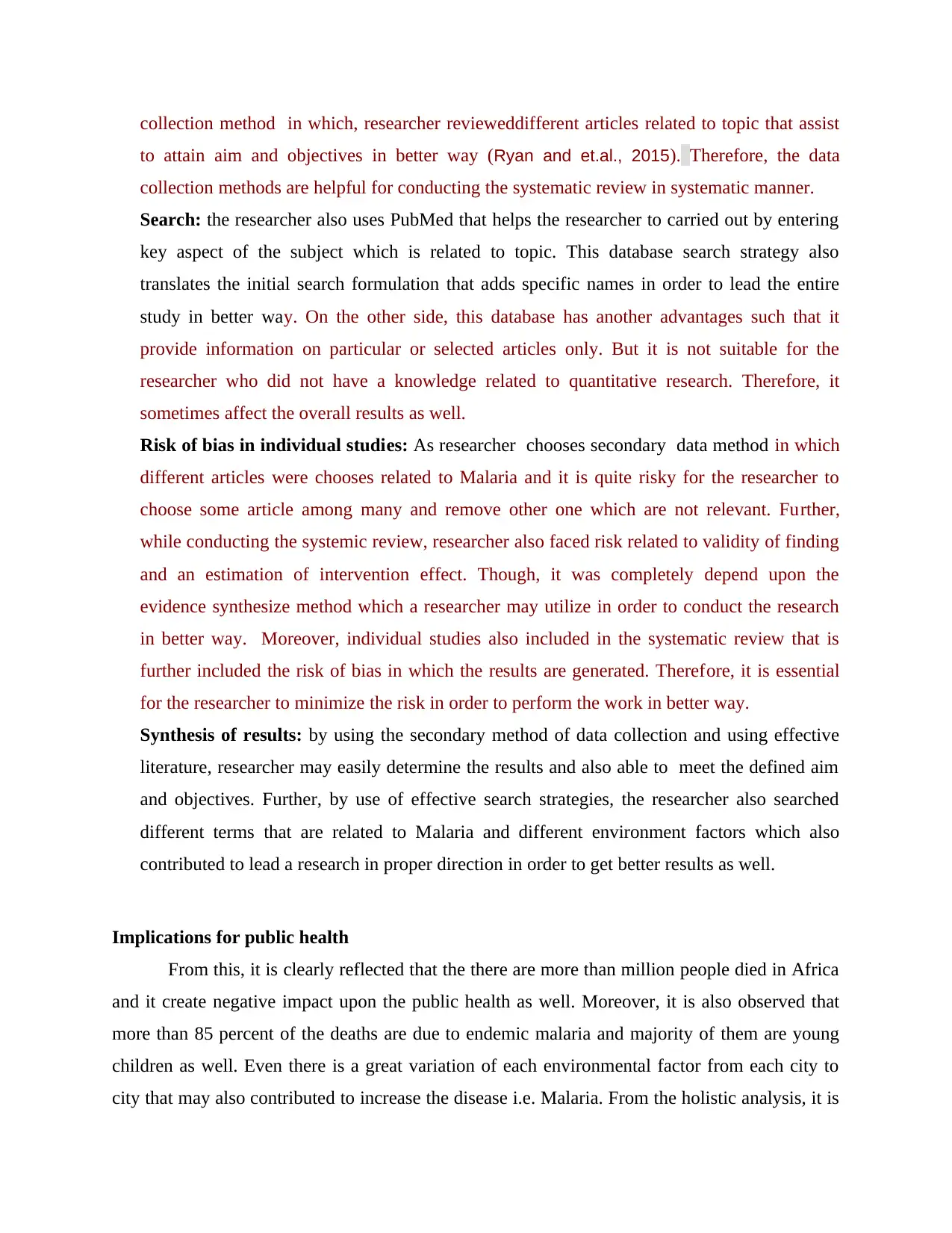
collection method in which, researcher revieweddifferent articles related to topic that assist
to attain aim and objectives in better way (Ryan and et.al., 2015). Therefore, the data
collection methods are helpful for conducting the systematic review in systematic manner.
Search: the researcher also uses PubMed that helps the researcher to carried out by entering
key aspect of the subject which is related to topic. This database search strategy also
translates the initial search formulation that adds specific names in order to lead the entire
study in better way. On the other side, this database has another advantages such that it
provide information on particular or selected articles only. But it is not suitable for the
researcher who did not have a knowledge related to quantitative research. Therefore, it
sometimes affect the overall results as well.
Risk of bias in individual studies: As researcher chooses secondary data method in which
different articles were chooses related to Malaria and it is quite risky for the researcher to
choose some article among many and remove other one which are not relevant. Further,
while conducting the systemic review, researcher also faced risk related to validity of finding
and an estimation of intervention effect. Though, it was completely depend upon the
evidence synthesize method which a researcher may utilize in order to conduct the research
in better way. Moreover, individual studies also included in the systematic review that is
further included the risk of bias in which the results are generated. Therefore, it is essential
for the researcher to minimize the risk in order to perform the work in better way.
Synthesis of results: by using the secondary method of data collection and using effective
literature, researcher may easily determine the results and also able to meet the defined aim
and objectives. Further, by use of effective search strategies, the researcher also searched
different terms that are related to Malaria and different environment factors which also
contributed to lead a research in proper direction in order to get better results as well.
Implications for public health
From this, it is clearly reflected that the there are more than million people died in Africa
and it create negative impact upon the public health as well. Moreover, it is also observed that
more than 85 percent of the deaths are due to endemic malaria and majority of them are young
children as well. Even there is a great variation of each environmental factor from each city to
city that may also contributed to increase the disease i.e. Malaria. From the holistic analysis, it is
to attain aim and objectives in better way (Ryan and et.al., 2015). Therefore, the data
collection methods are helpful for conducting the systematic review in systematic manner.
Search: the researcher also uses PubMed that helps the researcher to carried out by entering
key aspect of the subject which is related to topic. This database search strategy also
translates the initial search formulation that adds specific names in order to lead the entire
study in better way. On the other side, this database has another advantages such that it
provide information on particular or selected articles only. But it is not suitable for the
researcher who did not have a knowledge related to quantitative research. Therefore, it
sometimes affect the overall results as well.
Risk of bias in individual studies: As researcher chooses secondary data method in which
different articles were chooses related to Malaria and it is quite risky for the researcher to
choose some article among many and remove other one which are not relevant. Further,
while conducting the systemic review, researcher also faced risk related to validity of finding
and an estimation of intervention effect. Though, it was completely depend upon the
evidence synthesize method which a researcher may utilize in order to conduct the research
in better way. Moreover, individual studies also included in the systematic review that is
further included the risk of bias in which the results are generated. Therefore, it is essential
for the researcher to minimize the risk in order to perform the work in better way.
Synthesis of results: by using the secondary method of data collection and using effective
literature, researcher may easily determine the results and also able to meet the defined aim
and objectives. Further, by use of effective search strategies, the researcher also searched
different terms that are related to Malaria and different environment factors which also
contributed to lead a research in proper direction in order to get better results as well.
Implications for public health
From this, it is clearly reflected that the there are more than million people died in Africa
and it create negative impact upon the public health as well. Moreover, it is also observed that
more than 85 percent of the deaths are due to endemic malaria and majority of them are young
children as well. Even there is a great variation of each environmental factor from each city to
city that may also contributed to increase the disease i.e. Malaria. From the holistic analysis, it is
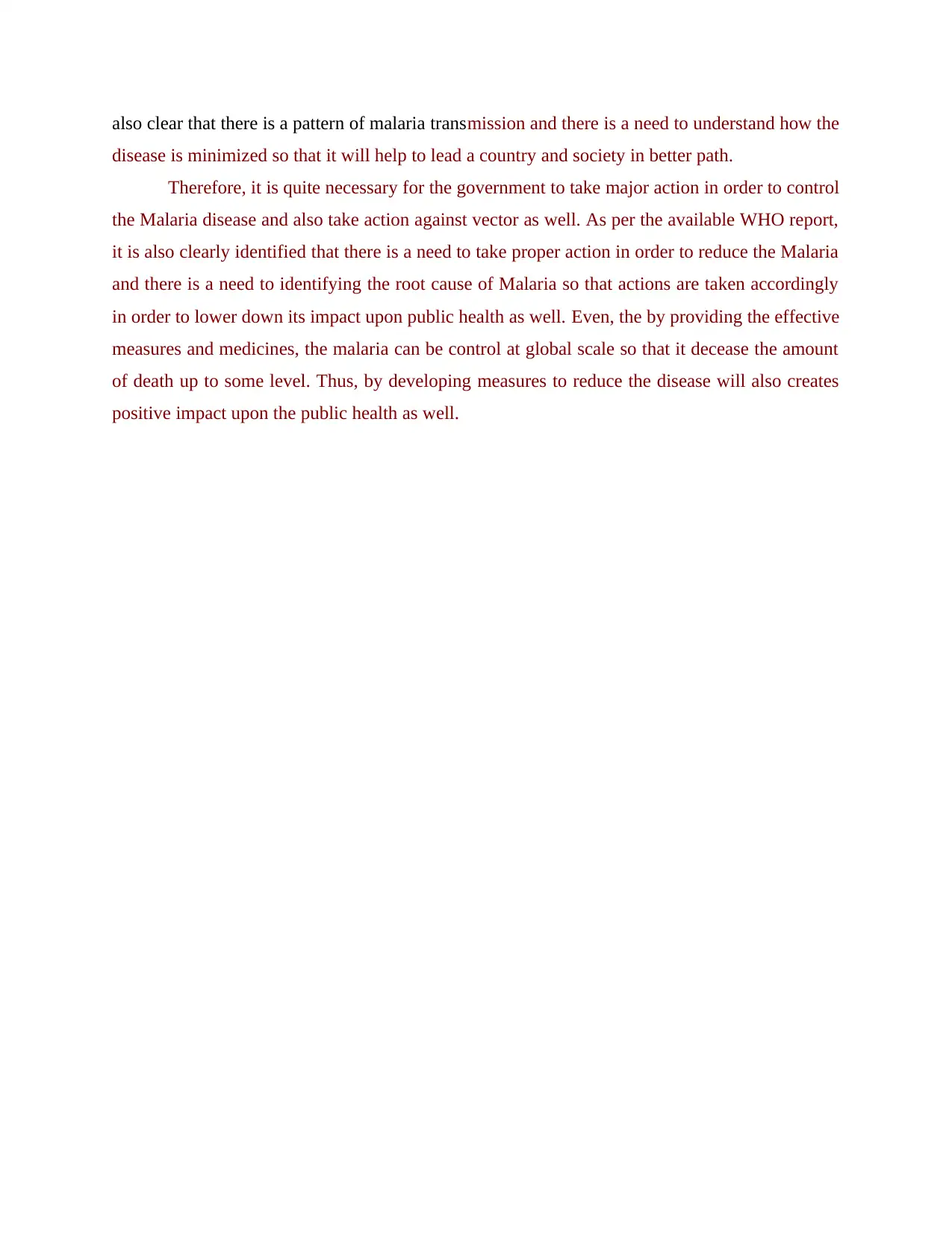
also clear that there is a pattern of malaria transmission and there is a need to understand how the
disease is minimized so that it will help to lead a country and society in better path.
Therefore, it is quite necessary for the government to take major action in order to control
the Malaria disease and also take action against vector as well. As per the available WHO report,
it is also clearly identified that there is a need to take proper action in order to reduce the Malaria
and there is a need to identifying the root cause of Malaria so that actions are taken accordingly
in order to lower down its impact upon public health as well. Even, the by providing the effective
measures and medicines, the malaria can be control at global scale so that it decease the amount
of death up to some level. Thus, by developing measures to reduce the disease will also creates
positive impact upon the public health as well.
disease is minimized so that it will help to lead a country and society in better path.
Therefore, it is quite necessary for the government to take major action in order to control
the Malaria disease and also take action against vector as well. As per the available WHO report,
it is also clearly identified that there is a need to take proper action in order to reduce the Malaria
and there is a need to identifying the root cause of Malaria so that actions are taken accordingly
in order to lower down its impact upon public health as well. Even, the by providing the effective
measures and medicines, the malaria can be control at global scale so that it decease the amount
of death up to some level. Thus, by developing measures to reduce the disease will also creates
positive impact upon the public health as well.
⊘ This is a preview!⊘
Do you want full access?
Subscribe today to unlock all pages.

Trusted by 1+ million students worldwide
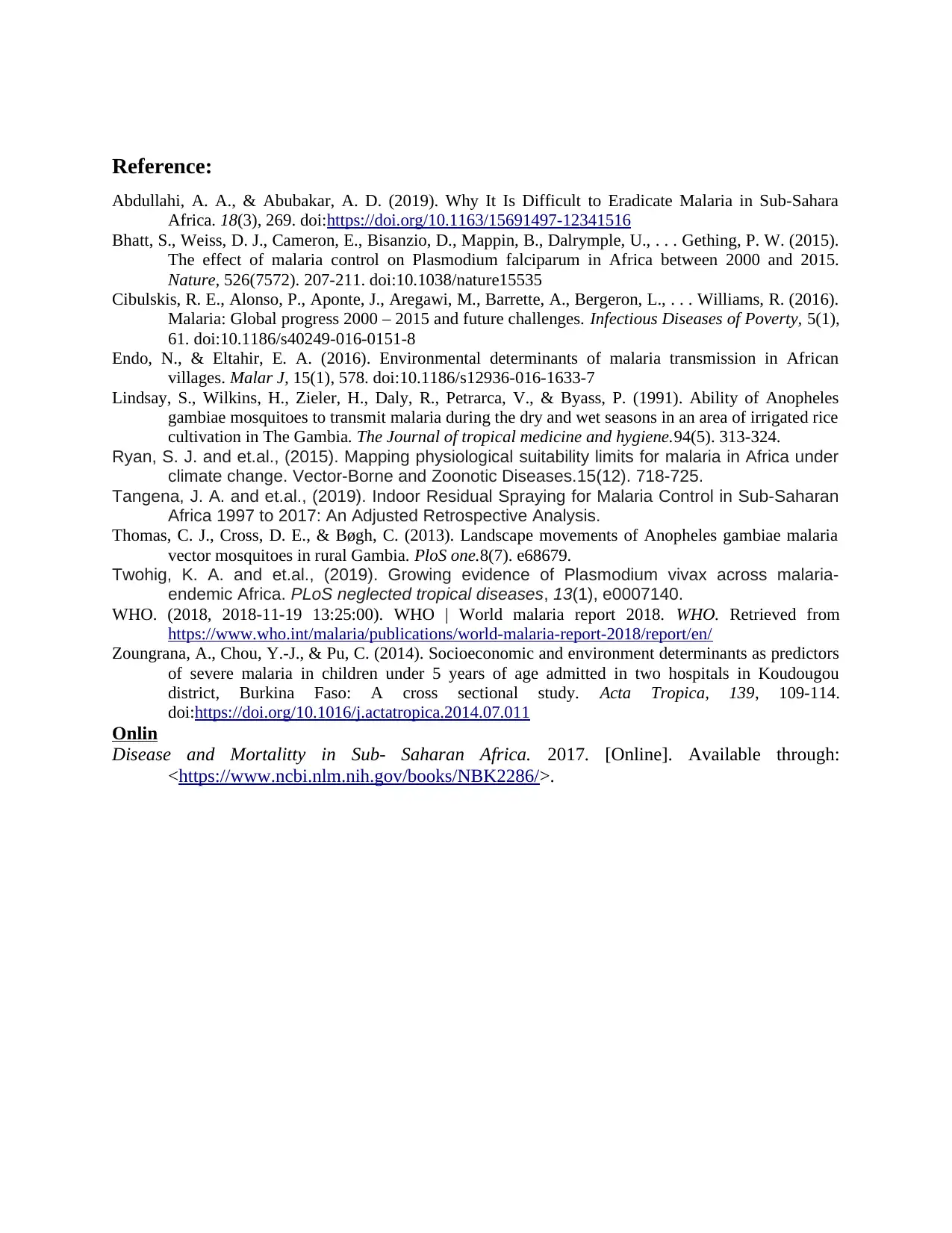
Reference:
Abdullahi, A. A., & Abubakar, A. D. (2019). Why It Is Difficult to Eradicate Malaria in Sub-Sahara
Africa. 18(3), 269. doi:https://doi.org/10.1163/15691497-12341516
Bhatt, S., Weiss, D. J., Cameron, E., Bisanzio, D., Mappin, B., Dalrymple, U., . . . Gething, P. W. (2015).
The effect of malaria control on Plasmodium falciparum in Africa between 2000 and 2015.
Nature, 526(7572). 207-211. doi:10.1038/nature15535
Cibulskis, R. E., Alonso, P., Aponte, J., Aregawi, M., Barrette, A., Bergeron, L., . . . Williams, R. (2016).
Malaria: Global progress 2000 – 2015 and future challenges. Infectious Diseases of Poverty, 5(1),
61. doi:10.1186/s40249-016-0151-8
Endo, N., & Eltahir, E. A. (2016). Environmental determinants of malaria transmission in African
villages. Malar J, 15(1), 578. doi:10.1186/s12936-016-1633-7
Lindsay, S., Wilkins, H., Zieler, H., Daly, R., Petrarca, V., & Byass, P. (1991). Ability of Anopheles
gambiae mosquitoes to transmit malaria during the dry and wet seasons in an area of irrigated rice
cultivation in The Gambia. The Journal of tropical medicine and hygiene.94(5). 313-324.
Ryan, S. J. and et.al., (2015). Mapping physiological suitability limits for malaria in Africa under
climate change. Vector-Borne and Zoonotic Diseases.15(12). 718-725.
Tangena, J. A. and et.al., (2019). Indoor Residual Spraying for Malaria Control in Sub-Saharan
Africa 1997 to 2017: An Adjusted Retrospective Analysis.
Thomas, C. J., Cross, D. E., & Bøgh, C. (2013). Landscape movements of Anopheles gambiae malaria
vector mosquitoes in rural Gambia. PloS one.8(7). e68679.
Twohig, K. A. and et.al., (2019). Growing evidence of Plasmodium vivax across malaria-
endemic Africa. PLoS neglected tropical diseases, 13(1), e0007140.
WHO. (2018, 2018-11-19 13:25:00). WHO | World malaria report 2018. WHO. Retrieved from
https://www.who.int/malaria/publications/world-malaria-report-2018/report/en/
Zoungrana, A., Chou, Y.-J., & Pu, C. (2014). Socioeconomic and environment determinants as predictors
of severe malaria in children under 5 years of age admitted in two hospitals in Koudougou
district, Burkina Faso: A cross sectional study. Acta Tropica, 139, 109-114.
doi:https://doi.org/10.1016/j.actatropica.2014.07.011
Onlin
Disease and Mortalitty in Sub- Saharan Africa. 2017. [Online]. Available through:
<https://www.ncbi.nlm.nih.gov/books/NBK2286/>.
Abdullahi, A. A., & Abubakar, A. D. (2019). Why It Is Difficult to Eradicate Malaria in Sub-Sahara
Africa. 18(3), 269. doi:https://doi.org/10.1163/15691497-12341516
Bhatt, S., Weiss, D. J., Cameron, E., Bisanzio, D., Mappin, B., Dalrymple, U., . . . Gething, P. W. (2015).
The effect of malaria control on Plasmodium falciparum in Africa between 2000 and 2015.
Nature, 526(7572). 207-211. doi:10.1038/nature15535
Cibulskis, R. E., Alonso, P., Aponte, J., Aregawi, M., Barrette, A., Bergeron, L., . . . Williams, R. (2016).
Malaria: Global progress 2000 – 2015 and future challenges. Infectious Diseases of Poverty, 5(1),
61. doi:10.1186/s40249-016-0151-8
Endo, N., & Eltahir, E. A. (2016). Environmental determinants of malaria transmission in African
villages. Malar J, 15(1), 578. doi:10.1186/s12936-016-1633-7
Lindsay, S., Wilkins, H., Zieler, H., Daly, R., Petrarca, V., & Byass, P. (1991). Ability of Anopheles
gambiae mosquitoes to transmit malaria during the dry and wet seasons in an area of irrigated rice
cultivation in The Gambia. The Journal of tropical medicine and hygiene.94(5). 313-324.
Ryan, S. J. and et.al., (2015). Mapping physiological suitability limits for malaria in Africa under
climate change. Vector-Borne and Zoonotic Diseases.15(12). 718-725.
Tangena, J. A. and et.al., (2019). Indoor Residual Spraying for Malaria Control in Sub-Saharan
Africa 1997 to 2017: An Adjusted Retrospective Analysis.
Thomas, C. J., Cross, D. E., & Bøgh, C. (2013). Landscape movements of Anopheles gambiae malaria
vector mosquitoes in rural Gambia. PloS one.8(7). e68679.
Twohig, K. A. and et.al., (2019). Growing evidence of Plasmodium vivax across malaria-
endemic Africa. PLoS neglected tropical diseases, 13(1), e0007140.
WHO. (2018, 2018-11-19 13:25:00). WHO | World malaria report 2018. WHO. Retrieved from
https://www.who.int/malaria/publications/world-malaria-report-2018/report/en/
Zoungrana, A., Chou, Y.-J., & Pu, C. (2014). Socioeconomic and environment determinants as predictors
of severe malaria in children under 5 years of age admitted in two hospitals in Koudougou
district, Burkina Faso: A cross sectional study. Acta Tropica, 139, 109-114.
doi:https://doi.org/10.1016/j.actatropica.2014.07.011
Onlin
Disease and Mortalitty in Sub- Saharan Africa. 2017. [Online]. Available through:
<https://www.ncbi.nlm.nih.gov/books/NBK2286/>.
1 out of 10
Related Documents
Your All-in-One AI-Powered Toolkit for Academic Success.
+13062052269
info@desklib.com
Available 24*7 on WhatsApp / Email
![[object Object]](/_next/static/media/star-bottom.7253800d.svg)
Unlock your academic potential
Copyright © 2020–2025 A2Z Services. All Rights Reserved. Developed and managed by ZUCOL.





